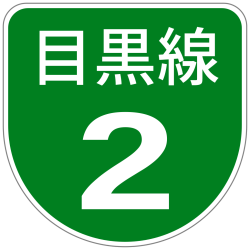Stadtautobahn Tokio C1
| Stadtautobahn Tokio C1 in Japan | |||||||||||||||||||||||||||||||||||||||||||||||||||||||||||||||||||||||||||||||||||||||||||||||||||||||||||||
 | |||||||||||||||||||||||||||||||||||||||||||||||||||||||||||||||||||||||||||||||||||||||||||||||||||||||||||||
| Basisdaten | |||||||||||||||||||||||||||||||||||||||||||||||||||||||||||||||||||||||||||||||||||||||||||||||||||||||||||||
| Betreiber: | Shuto Kōsokudōro | ||||||||||||||||||||||||||||||||||||||||||||||||||||||||||||||||||||||||||||||||||||||||||||||||||||||||||||
| Straßenbeginn: | Chūō (35° 41′ 4″ N, 139° 46′ 40″ O) | ||||||||||||||||||||||||||||||||||||||||||||||||||||||||||||||||||||||||||||||||||||||||||||||||||||||||||||
| Straßenende: | Chūō (35° 41′ 4″ N, 139° 46′ 40″ O) | ||||||||||||||||||||||||||||||||||||||||||||||||||||||||||||||||||||||||||||||||||||||||||||||||||||||||||||
| Gesamtlänge: | 14,8 km | ||||||||||||||||||||||||||||||||||||||||||||||||||||||||||||||||||||||||||||||||||||||||||||||||||||||||||||
| Nutzungsvoraussetzung: | Mautpflichtig | ||||||||||||||||||||||||||||||||||||||||||||||||||||||||||||||||||||||||||||||||||||||||||||||||||||||||||||
Straßenverlauf
| |||||||||||||||||||||||||||||||||||||||||||||||||||||||||||||||||||||||||||||||||||||||||||||||||||||||||||||
Die Stadtautobahn Tokio C1 (jap. 首都高速都心環状線, shuto kōsoku toshinkanjō-sen, „Innenstadtringlinie der Hauptstadt-Autobahn[en]“, engl. Shuto Expressway Inner Circular Route) ist eine knapp 15 km lange Autobahnstrecke der Stadtautobahn Tokio im Zentrum der japanischen Hauptstadt Tokio. Sie führt als geschlossener Ring durch die Bezirke Chūō, Minato und Chiyoda, angeschlossen sind außen mit den Linien 1 bis 6 der Stadtautobahn Tokio die wichtigsten Strecken in die äußeren Bezirke und zu den nationalen Autobahnen und innen die Yaesu-Linie (Y) sowie die ältere, private Autobahn Tokio. Auf Straßenschildern wird der Name der Autobahn lateinisch-arabisch mit C1 (C wie circular) und japanisch mit 環 („Ring“) oder 都環 („Hauptstadtring“) abgekürzt und teilweise zusammen mit einem Kreispfeil ausgezeichnet, der die Fahrtrichtung anzeigt.
1962 wurde das erste, 4,5 km lange Teilstück zwischen den Anschlussstellen Kyōbashi und Shibaura dem Verkehr übergeben. Dies war zugleich die erste Strecke der Stadtautobahn, die als öffentliches Unternehmen (kōdan) 1959 gegründet worden war. Bis zur Eröffnung der Olympischen Sommerspiele 1964 wurden schrittweise die meisten Streckenabschnitte eröffnet; nur das südwestliche, knapp vier Kilometer lange Teilstück zwischen Kasumigaseki und Shiba-Kōen wurde erst im Juli 1967 befahrbar.
Im Westen, wo der Ring nahe am inneren Graben des heutigen Kaiserpalasts entlangführt, verläuft er durch den 1900 Meter langen Chiyoda-Tunnel unter dem Obersten Gerichtshof und dem Nationaltheater. An mehreren Stellen befinden sich kleinere Tunnel, im Nordosten liegt der Autobahnring als Hochstraße über dem Nihonbashigawa und damit auch über der Nihonbashi, einem traditionellen Wahrzeichen Tokios. Dort beginnt auf dem Innenstadtring auch die transkontinentale AH1, die ihn im Westen über die Shibuya-Linie (3) wieder verlässt.
Im Kitanomaru-Park in Chiyoda nutzten 2005 täglich über 120.000 Fahrzeuge die Autobahn, in Hatchōbori in Chūō waren es rund 93.000.[1]
Galerie
- An der Anschlussstelle Ginza quert die Unemebashi, ursprünglich eine Brücke über den 1964 zugeschütteten Tsukiji
Weblinks
- Shuto Kōsokudōro: Streckenplan
Einzelnachweise
- ↑ MLIT, „Straßenverkehrszählung“ (dōrō kōtsū sensasu, wird wie die Volkszählung alle fünf Jahre durchgeführt) Fiskaljahr 2005: Präfektur Tokio, Shuto-Autobahnen
Auf dieser Seite verwendete Medien
(Autobahn)tunnel (Icon). Gezeichnet nach dem Vorbild schweizerischer Verkehrsschilder.
Nach links zeigendes schwarzes Dreieck ◀, U+25C0 aus dem Unicode-Block Geometrische Formen (25A0–25FF)
Nach rechts zeigendes schwarzes Dreieck ▶, U+25B6 aus dem Unicode-Block Geometrische Formen (25A0–25FF)
Schild des Asiatische Fernstraße 1
This is a diagram of Shuto Urban Expwy
Sign. This image's glyphs are the outline path from free font that is "VL Gothic". If you want to change the glyphs, you MUST check the license of substitute glyphs/fonts.
This is a diagram of Shuto Urban Expwy
Sign. This image's glyphs are the outline path from free font that is "VL Gothic". If you want to change the glyphs, you MUST check the license of substitute glyphs/fonts.
This is a diagram of Shuto Urban Expwy
Sign. This image's glyphs are the outline path from free font that is "VL Gothic". If you want to change the glyphs, you MUST check the license of substitute glyphs/fonts.
Motorway Exit Icon in green for left-hand driving areas
This is a diagram of Shuto Urban Expwy
Sign. This image's glyphs are the outline path from free font that is "VL Gothic". If you want to change the glyphs, you MUST check the license of substitute glyphs/fonts.
This is a diagram of Shuto Urban Expwy
Sign. This image's glyphs are the outline path from free font that is "VL Gothic". If you want to change the glyphs, you MUST check the license of substitute glyphs/fonts.
This is a diagram of Shuto Urban Expwy
Sign. This image's glyphs are the outline path from free font that is "VL Gothic". If you want to change the glyphs, you MUST check the license of substitute glyphs/fonts.
This is a diagram of Japanese National Route Sign. The glyphs of 国道 are the outline path from free font that is "NARAYAMA Maru Gothic" created by excl-zoo, based on "Wadalab Hosomaru Gothic". If you want to change the glyphs, you MUST check the license of substitute glyphs/fonts.
ja: 日本の国道標識。「国道」のグリフは「和田研細丸ゴシック」を種字とし excl-zoo が作成した「ならやま丸ゴシック」のアウトラインパスである。もし、「国道」のグリフを変更する場合は、変更に使用するフォントのライセンスを確認すること。特にグリフをアウトライン化して埋め込む場合、多くのフォントは商用利用に制限が存在する。
This is a diagram of Shuto Urban Expwy
Sign. This image's glyphs are the outline path from free font that is "VL Gothic". If you want to change the glyphs, you MUST check the license of substitute glyphs/fonts.
This is a diagram of Shuto Urban Expwy
Sign. This image's glyphs are the outline path from free font that is "VL Gothic". If you want to change the glyphs, you MUST check the license of substitute glyphs/fonts.
















